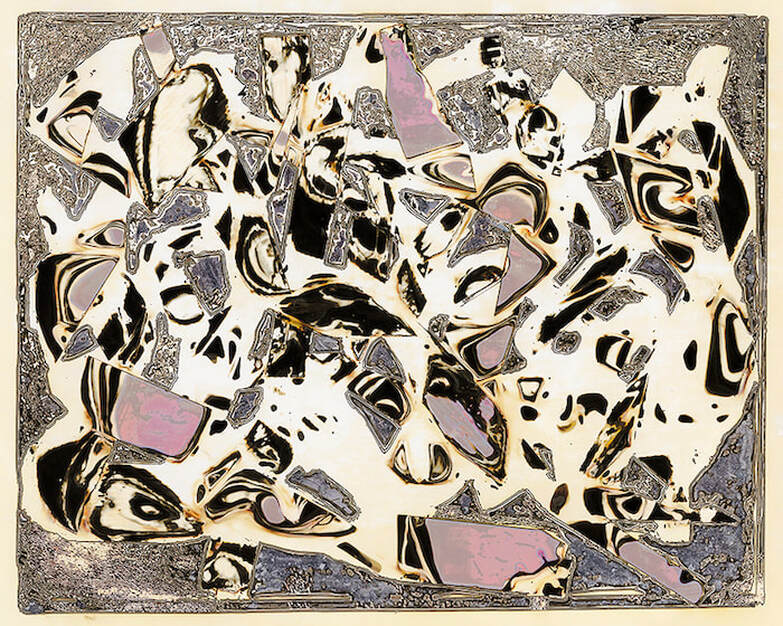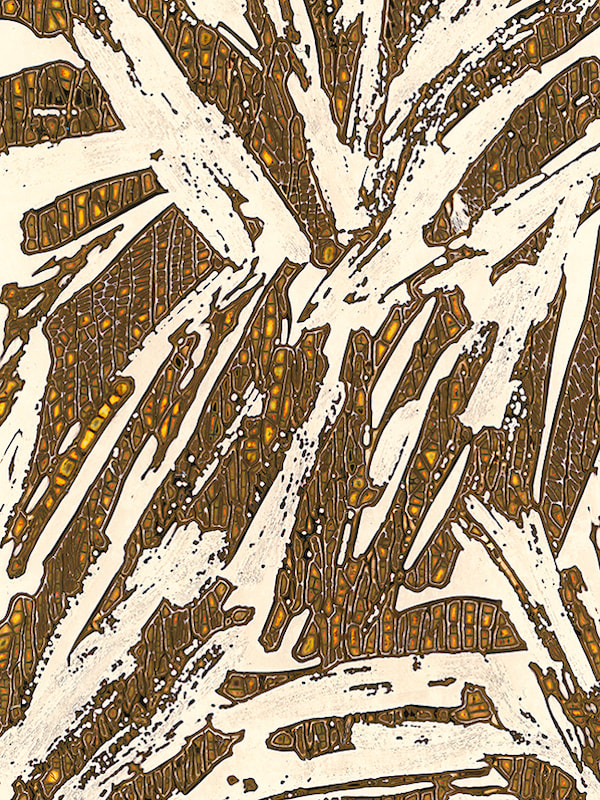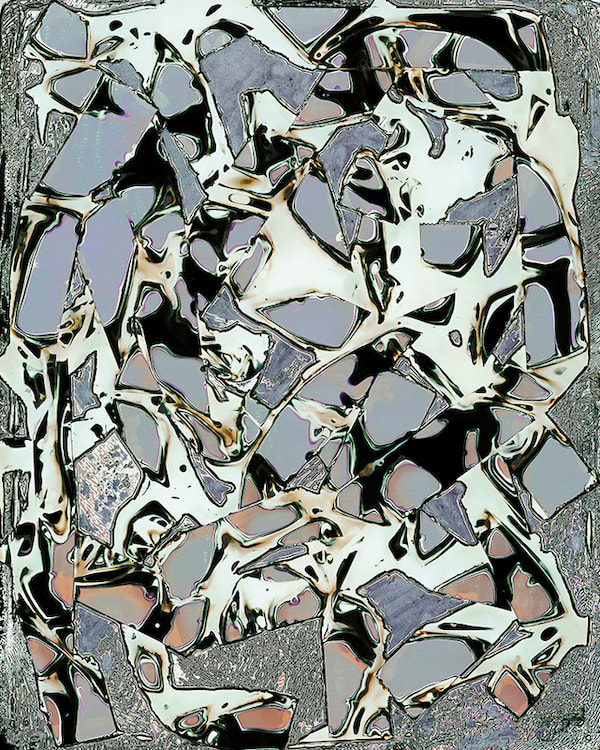Alex Hedison
A Brief Infinity
Alex Hedison
ABI_045, 2022
Hahnemühle photo rag satin paper
25.875 x 36.5 inches (65.7 x 92.7 cm)
Edition 1 of 5 + 2AP, on verso
ABI_045, 2022
Hahnemühle photo rag satin paper
25.875 x 36.5 inches (65.7 x 92.7 cm)
Edition 1 of 5 + 2AP, on verso
A Brief Infinity
Alex Hedison is known for photography that highlights the ‘in between’ state – a play between the ambiguity of painting and photography that results in unintentional abstract compositions. “A Brief Infinity'', currently on show at Von Lintel Gallery in Los Angeles, is Hedison’s latest body of work that pushes her image-making further, to an evolved and highly conceptual state. Following the isolation brought on by COVID-19 and unable to photograph outdoors, Hedison chose to bring her practice indoors by starting to improvise in the darkroom. This evolutionary journey resulted in the creation of a series of chemigrams, which she then photographed, creating intentional abstract records of a shifting landscape. Gold Circle is thrilled to showcase these new works alongside an in-depth interview with the artist, unfolding the story behind the concepts, making processes and presentation of these new works. |
Alex Hedison
ABI_028, 2022
Canson Baryta paper and silver metallic paint
28.875 x 36.125 inches (73.3 x 91.8 cm)
Edition 1 of 5 + 2AP, on verso
ABI_028, 2022
Canson Baryta paper and silver metallic paint
28.875 x 36.125 inches (73.3 x 91.8 cm)
Edition 1 of 5 + 2AP, on verso
In “A Brief Infinity”, you introduce us to a new image-making approach within your practice. Can you tell us about what drove you to explore new techniques and how you started to work with chemigrams?
I started experimenting with photograms after my parents passed away in 2016 and then 2019. Sifting through memorabilia in my childhood home, I wanted to make records of the everyday objects that were once held in my parents’ hands. I was compelled to create direct impressions on black + white photographic paper without the interference of a camera, to tell a story that evolved over time. With tape from my parents' office drawer, dish soap from their kitchen and other quotidian objects, I started experimenting in the darkroom. I became aware of the way the materials created a resistive effect that alternatively delayed and facilitated the effect of light and chemicals on the paper. It was through research about chemigrams that I discovered the work of Pierre Cordier and other artists who pioneered the process. 2020 was a time of tremendous uncertainty but the pandemic also created space for possibility. I became willing to take the experimentation I had already begun even further and embrace the unpredictability that I saw reflected in the process of making chemigrams. During a time of quarantine, the darkroom was exactly the place I wanted to be. There is a very interesting and creative dynamic between the original chemigrams and the final pieces being records of the evolving process. How do you see the relationship between the original chemigram and its corresponding records in time? Do you consider the originals to be a part of the work, or are they more means to getting to the final pieces?
The original chemigrams still exist. They are changing, darkening, shape-shifting as we speak. Their fluid lifespan is testament to the path of the natural effects created from alchemy as they react to all manner of encountered influences. My interest is in the transient junctures that happen between the initial phase in the process of becoming and the final stages of development. The work of “A Brief Infinity” are records in time attesting to one singular fleeting moment. |
Alex Hedison
ABI_039, 2022
Epson metallic gloss paper
14.5 x 11 inches (36.8 x 27.9 cm)
Edition 3 of 5 + 2AP, on verso
ABI_039, 2022
Epson metallic gloss paper
14.5 x 11 inches (36.8 x 27.9 cm)
Edition 3 of 5 + 2AP, on verso
Once created and photographed, what happens to the original chemigrams? Would you ever re-use these at all as the work evolves?
For now, they live in my work drawers. I visit the original chemigrams from time to time and carefully pull them from their light occluding envelopes for a peak. Each time I do they change some more by contact to air and light. Perhaps I’ll return to them and consider how they can be a part of new work. I will be changed then too and we can greet each other as new yet familiar creative friends. |
From a visual and aesthetics perspective, the works in “A Brief Infinity” are intricate, vibrant and deeply engaging. Can you describe the process you follow in the studio during the different stages of making and how you take creative decisions?
I’d love to say that I just allow the process to unfold but in fact I’m always battling with my desire to control the outcome. The creative decisions I made initially originated from experimentation. Any attempt to repeat what I discovered was more about predictability than chance. Thankfully with chemigrams, my impulse to achieve a desired result inevitably yielded something unanticipated. Many times, this was even better than that which I had tried to influence. I was engaged in a dance between control and chaos, certainty and uncertainty. Chemigrams are both a literal and metaphoric struggle between the process and its resistance. In both cases, the process always wins. What would you say are the biggest technical challenges, from a craftsmanship perspective?
Because I photographed chemigrams as they were changing, the biggest challenge was timing. If I waited too long, I would lose the brightness of the colours or what was compelling about the way they interacted with the chemicals. Also, the chemigrams were wet so photographing them without the reflection on the surface of the paper was tricky. I’m sure there’s a better system of tracking the changes with a camera. I just haven’t figured it out yet. |
Alex Hedison
ABI_07, 2022
Canson Baryta paper and silver metallic paint
34.125 x 22.625 inches (86.7 x 57.5 cm)
Edition 1 of 5 +2AP, on verso
ABI_07, 2022
Canson Baryta paper and silver metallic paint
34.125 x 22.625 inches (86.7 x 57.5 cm)
Edition 1 of 5 +2AP, on verso
You describe the period of the pandemic and the loss of control we all experienced as a driving force behind your decision to voluntarily give up control within your own practice. For a photographer, in particular, this is a significant departure step to take. Can you tell us about how this period affected you as an artist?
The pandemic was a period of supreme loss and disorientation. So much of my identity was wrapped around driving life, using meaningful intention to make things happen. None of that was working. I had to throw up my hands and admit defeat, get bored, go quiet, wander…and wonder. At first it felt like a painful surrender to this new world. Once I started experimenting in the darkroom, not knowing where it would lead me, my understanding that being lost is a pre-requisite to discovery was no longer theoretical. What had been the subject of my work- the ‘in between’ – I was experiencing myself. In the darkroom, there were a lot of dead ends and unappealing results. Amid the energy of frustration was a giddiness. I wanted more. Every day brought the aliveness that comes with not knowing, with the freedom from result thinking. I was able to make physical contact with an intuitive connection to the chemigrams I was creating. I loved them. I hated them. I didn’t even know why. My mind came second to the experience. That is a gift to an artist. I feel very changed by this process. |
Alex Hedison
ABI_016, 2022
Espon metallic gloss paper
17.75 x 13.5 inches (45.1 x 34.3 cm)
Edition 4 of 5 + 2AP, on verso
ABI_016, 2022
Espon metallic gloss paper
17.75 x 13.5 inches (45.1 x 34.3 cm)
Edition 4 of 5 + 2AP, on verso
|
Compared to representational photography, “A Brief Infinity” conveys a very strong link with abstract expressionist painting, through the way the images are constructed visually. Is this cross-disciplinary dimension something that you have considered at all when creating the works, or do you see them as firmly rooted within photography?The chemigrams themselves would be more linked to painting since they are compositions using photo chemistry and light. However, they are also photographs because they represent a moment in time recorded during an event which would not exist had it not been for the intervention of a camera. But then I could trouble this further because I used the same paint as a resist in the chemigram process that I applied to the final photographic prints. So yes, there’s a definite overlap in disciplines while rooted to the fundamental principles and materiality of photography. |
Alex Hedison
ABI_031, 2022
Canson Baryta paper and silver metallic paint
18 x 14.375 inches (45.7 x 36.5 cm)
Edition 5 of 5 + 2AP, on verso
ABI_031, 2022
Canson Baryta paper and silver metallic paint
18 x 14.375 inches (45.7 x 36.5 cm)
Edition 5 of 5 + 2AP, on verso
Are there any artists or other visual references that you drew inspiration from?
While other artists' work specifically weren’t conscious considerations when I was making the chemigrams, there’s a definite relationship to artistic influences including Abstract Expressionism but also to the geometric patterns found in 20th century African Kuba Shoowa textiles and Aboriginal bark paintings. From Paul Klee, Lee Krasner and Alma Thomas to those who have pushed the boundaries of photography such as Pierre Cordier, Marco Breuer, Farrah Karapetian and Alison Rossiter, there’s a wide array of artists whose work has had an effect on my own. Also, mid-Century California painters like Richard Diebenkorn and Doyle Lane who made abstract paintings using clay. Alex Hedison
ABI_059, 2022 Canson Baryta paper and silver metallic paint 6 x 8 inches (15.2 x 20.3 cm) Edition 1 of 5 + 2AP, on verso |
|
All images ©Alex Hedison
Courtesy of Von Lintel Gallery, Los Angeles |
Alex Hedison |
Von Lintel Gallery |
|
Alex Hedison was born in Los Angeles, California in 1969. She is known for her abstracted and surreal photographs of landscapes and interiors. She often focusses on synthetic veils in ordinary environments, identifying conceptual space between places. Hedison has exhibited in Europe and the U.S. and her work in public and private collections.
www.alexandrahedison.com |
Founded by Tarrah von Lintel almost 30 years ago, Von Lintel Gallery has continually developed its discerning curatorial point of view. The gallery predominantly features painting, photography and unique works on paper that are forward-thinking and challenging while maintaining a strong sense of aesthetic tradition. Focusing on a selective roster of artists who quietly push the boundaries of medium and materiality, the gallery exhibits art that will continue to engage the viewer over time.
Tarrah von Lintel began her career in Paris, working first with Galerie Claire Burrus and then Thaddeus Ropac before opening her own gallery in Munich in 1993. Her gallery featured many NY artists, some of whom she continues to represent today, leading to her move to NYC’s growing Chelsea district in 1999. After 15 successful years in NY, the gallery relocated to Los Angeles, in recognition of LA’s growing importance on the international art scene. Von Lintel artists have shown or placed work in important public collections, among them The Metropolitan Museum of Art; Museum of Modern Art; The Whitney Museum of American Art; The Getty Museum; The International Center of Photography; Museum of Fine Arts, Boston; the Museum of Fine Arts, Houston; Los Angeles County Museum of Art; San Francisco Museum of Modern Art; the High Museum; The Getty; the Kemper Museum of Contemporary Art; and Londonʼs National Gallery of Art. The gallery is a member of the Art Dealers Association of America (ADAA) of which Tarrah von Lintel is currently also a board member. www.vonlintel.com |











